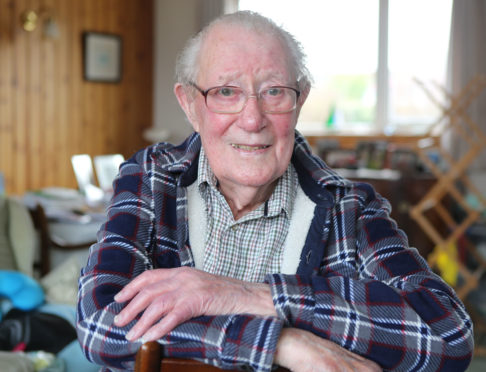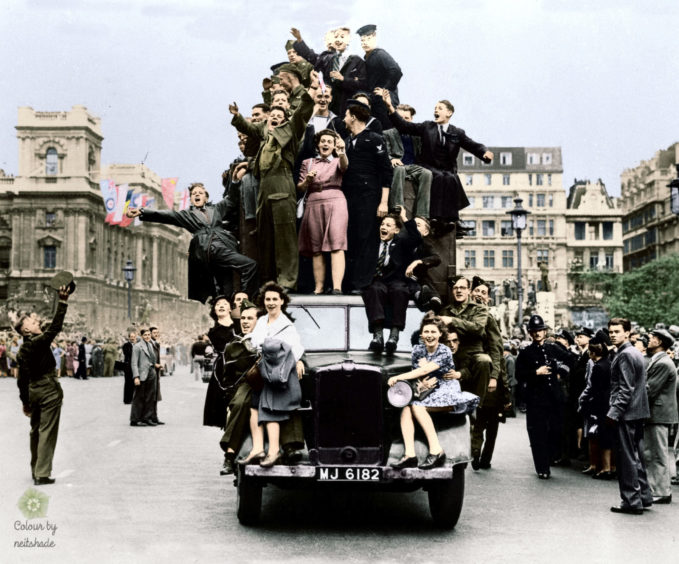
Around the world, it was a day to remember, an international celebration of Victory in Europe.
But, recuperating in an Italian hospital, Desert Rat John Webster hardly noticed.
On Friday, as Britain commemorates the 75th anniversary of VE Day, the 99-year-old veteran will look back on a day he hardly remembers.
On May 8, 1945, he had been evacuated out of Yugoslavia after being shot in the hand and was recovering from surgery in Taranto, Italy.
Now the great-grand-father, who is approaching his 100th birthday, recalls: “I went to hospital, was operated on then was told, it’s VE Day. I spent most of it in bed.”
For Mr Webster it seemed a low-key end to the bitter North Africa campaign, which was fought for control of the Suez Canal and the oil reserves of the Middle East. The Allies’ eventual victory against the Axis forces was a significant military achievement and a huge morale boost.
Private Webster served with the Royal Electrical and Mechanical Engineers (REME), attached to the 8th Army in North Africa, recovering and fixing tanks.
Born in Rutherglen but now living in Tain, Ross-shire, with wife, Pat, 84, Mr Webster was conscripted as a young mechanic in 1940.
Remembering the voyage to Africa, he said: “In Durban, there was a woman they called the lady in white. The ship was leaving and she sang to us as we were going out — opera, some beautiful songs, wonderful songs. There were a lot of Scots aboard and we sang back the song ‘We’re no awa’ tae bide awa’.”
Once in Africa, it was hot and dangerous work.
Mr Webster said: “One time, the tinsmith left his shears on the back [of a vehicle] and went for his lunch. He came back and picked it up and his hand was blistered.”
Mr Webster recalled how he and another lad called Tommy were shot at after they salvaged a Humber armoured car. “I was driving and I couldn’t see much at all. Tommy was up on the turret. Then a ricochet hit the armour. Bang! Sweat was pouring off me. I turned around and Tommy had fallen down, I thought he’d been hit. Then I saw blood pouring down me.”
Mr Webster had been grazed by flying metal, while Tommy had merely over- balanced. They escaped, but not everyone did.
“A friend was in a tank and a shell went down the turret. The worst thing is hearing someone burn to death. You dream about it.”
In charge of the Axis Afrika Corps was German General Erwin Rommel.
Pte Webster and his comrades always knew the man dubbed The Desert Fox was a formidable adversary, but John did not realise until after the campaign that he came within shooting distance of the charismatic German general.
Mr Webster told how he spied Rommel when taking cover after being ambushed.
He said: “A wee plane flew over us and landed, a long rifle shot away. A German staff car drove up to the plane and two fellows stepped out. A man then got out of the plane and they all spoke for a while before the two fellows saluted him and he returned the salute.
“The vehicle shot away and the fellow got back into his plane then flew off.’
Only later did Mr Webster learn Rommel had his own plane. “I saw a picture of him and that was who it was.”
In January 1942 the Afrika Corps advanced east to try to seize the Suez Canal, reaching the British line at El Alamein, Egypt on June 30, 1942.
Rommel attacked but Allied troops resisted and a stalemate developed before the second El Alamein battle in October-November 1942.
Mr Webster said: “When the big pushes came, with the second El Alamein…we were moved up to the road [the coast road which ran across the top of North Africa] to help out the New Zealanders and there was a real how do-you-do then. It was hard going.
“It was the first time we pushed the Axis people back,” Mr Webster recalled, although he admits he was “too busy getting on with it” to fully realise the significance.
Mr Webster was later parachuted into occupied Yugoslavia to help the local resistance and eventually evacuated to Italy by sea after being wounded.
Half-asleep on the ship, the noise of the propeller made him believe he was on the train to Glasgow.
Upon waking and realising he was in fact Italy-bound, he experienced what was perhaps his worst moment of the war. Mr Webster said: “It was the first time I went, ‘oh no’, because I thought I was back in Scotland!
“Looking back the camaraderie was something. The things we had to do were incredible.”

Enjoy the convenience of having The Sunday Post delivered as a digital ePaper straight to your smartphone, tablet or computer.
Subscribe for only £5.49 a month and enjoy all the benefits of the printed paper as a digital replica.
Subscribe © Associated Newspapers/Daily Mail/Shutterstock
© Associated Newspapers/Daily Mail/Shutterstock